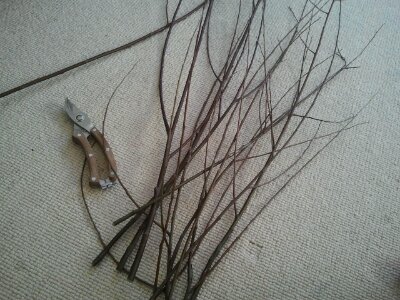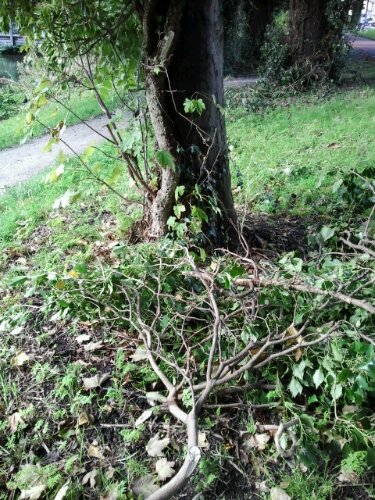

This morning a group Urban Herbies gathered alongside a park hedgerow and took cuttings of a wonderful herb shrub – Elder (Sambucus nigra). We are going to look after the cuttings for as long as it takes for them to find their feet and be mature enough to survive planted out, in another Amsterdam hedge or edge. I was inspired to try this by the work of Glennie Kindred, a wonderful, community spirited wise woman from Britain. Her website contains very useful information about many herbs and has especially detailed information about native trees. Thank you Glennie!
Here’s How to Make Elder Babies:
1. Most shrubs and trees are best propagated in the autumn and winter but its also possible to try easily-rooting Elder in the summer. Chose very healthy parts of very healthy shrubs, ask the permission of the shrub you are drawn to with your heart and actions. Be gentle, respectful and only harvest a little from one shrub. If your cuttings fail to survive then return them to the soil. Never burn Elder and listen to the wisdom it has to offer. All parts of the plant are medicinal and have been revered for millennia. These days we tend to make most use if the berries and flowers. The leaves and twigs also make an excellent skin cream but it is best not to ingest them.
2. We used secateurs or our hands to carefully remove the last 6-8 inches (14-20cm) of a healthy branch. Avoid those laden with berries, the plant’s energy needs to focus on that task rather than growing new roots.
3. Remove all but the last couple of leaf pairs, gently slide them off with your hands. Return these to the foot of the mother Elder. If harvesting in winter, all of the leaves could be removed from the cutting.
4. If using it, dip the bottom end of the cutting into a jar of Willow or Meadowsweet rooting hormone tea. Poke the cutting quite deeply into a pot of good quality soil, so that it is about half buried and won’t topple over. Firm the soil slightly.

5. Ideally, water the pot from beneath by standing it in a bowl of water for a while, until the soil is thoroughly dampened. Ensure that excess water can freely drain from the pot.
6. Place the pot, with damp soil and comfortably pushed-in cutting, in a place of semi shade, or in a loosly closed translucent plastic bag and leave it to grow roots. This will take some time so you’ll need to be patient, maybe for a few weeks. There is no need to remove the cutting to check on progress, just let it do it’s thing and you’ll be pleasantly surprised the day you see Elder roots, poking out of the drainage holes.
7. Keep an eye on the dampness of the soil, Elder will rot if it gets soggy but it will also die if the soil dries out completely. Lightly water the soil when needed. Misting with a water spray is a gentle way to water from above.
8. When the cutting has set down a good root network and has grown a couple of feet tall (about 50cm), it should be ready to plant out when mild spring weather arrives. This may take a couple of years but sometimes it can happen more quickly.
9. Plant out during moderate weather in an area where Elder bushes are sparse. Elder fairs well in most conditions, it will tolerate full sun, lots of shade or partial shade. A hedgerow setting is most suitable. The shrub can be pruned into a hedge if needed or allowed to grow in which ever direction it prefers.
Here’s another link to Gennie Kindred’s website where you will find lots of useful Elder information and several wonderful Elder recipes.

To make the Willow rooting tea simply harvest a few Willow tendrils, chop them and place in a clean glass jar. Cover with freshly boiled water and cover. Leave to infuse as the water cools, for about 8 hours. Then the infusion may be strained or not. It will keep a few days in the fridge if needed or use what you require and pour the rest on your other plants.











